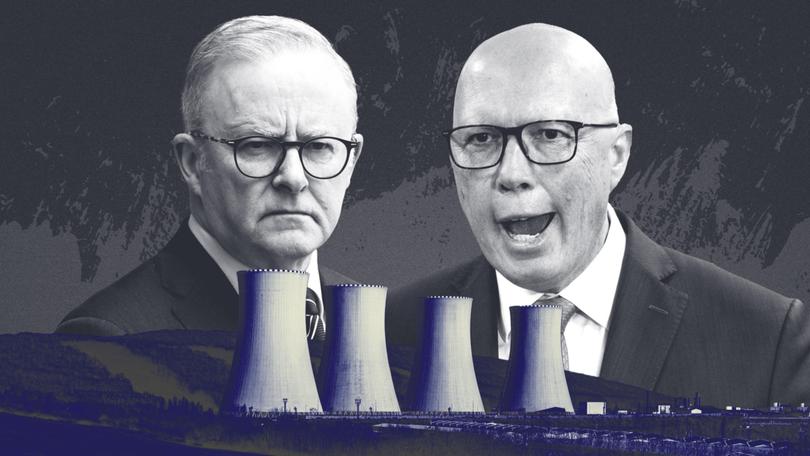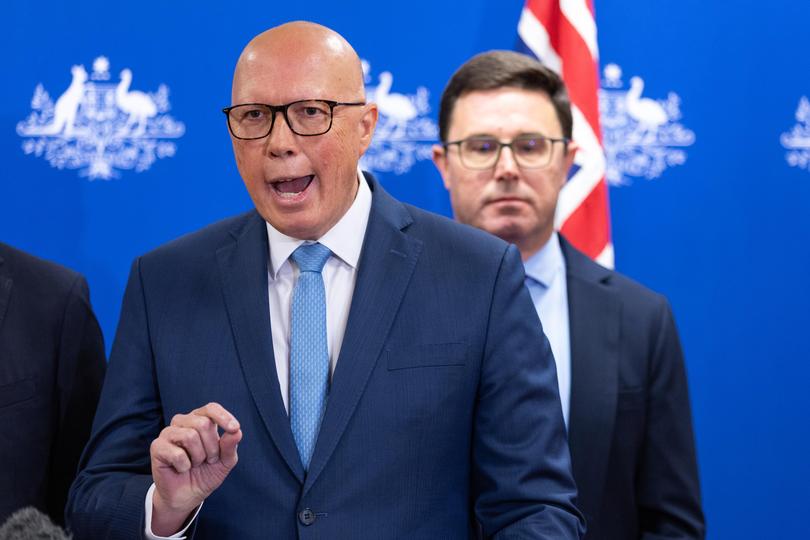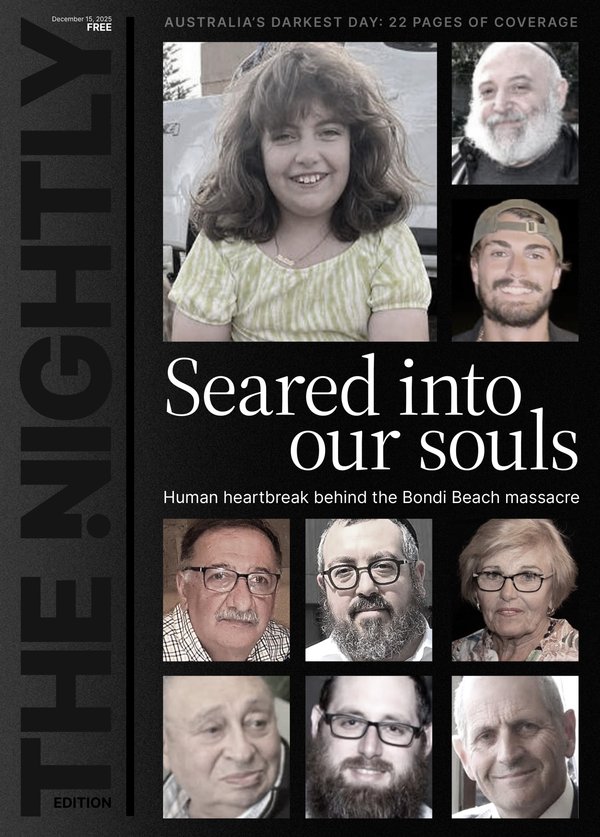Labor and the Coalition go nuclear at each other over Australia’s energy future as political insults fly

Labor and the Coalition on Friday accused each other of duping voters with “fantasy” electricity prices as opposition leader Peter Dutton triggered a bitter political war over nuclear energy.
Australia was at a “crossroads,” Mr Dutton said as he launched the first salvo by unveiling the Coalition’s controversial $331 billion plan to introduce nuclear power to the electricity grid over the next 25 years.
Mr Dutton said his proposal to convert seven coal-fired power station sites to nuclear power between 2035 and 2050 would save taxpayers $263 billion compared to Labor’s “zealot-like” renewables-only approach and “keep the lights on.”
Sign up to The Nightly's newsletters.
Get the first look at the digital newspaper, curated daily stories and breaking headlines delivered to your inbox.
By continuing you agree to our Terms and Privacy Policy.“This is a plan which will underpin the economic success of our country for the next century. This will make electricity reliable. It will make it more consistent. It will make it cheaper for Australians, and it will help us decarbonise as a trading economy, as we must,” he said.
The long-awaited costings plan, which has been in the works for months, provoked mirth from Prime Minister Anthony Albanese.
“It’s Friday the 13th, an auspicious day, I’ve got to say, for Peter Dutton to drop his nuclear nightmare policy out there,” he said.
“We know this is a plan for the 2040s and in the meantime, I’m not quite sure what he thinks will happen with energy security,” he added. “The truth is that renewables are the cheapest form of new energy. Everyone knows that that’s the case.”
As one of the most consequential issues to face Australians in generations descended into a slanging match, experts urged both sides to tone down the political bust-up.
Prof. Bruce Mountain, an energy economist from the Victorian Energy Policy Centre said it was impossible to guarantee the cost of any model of an energy transition because there are “simply too many uncertainties”.
This applied to both Coalition and Government policies, he said.
“It’s possible to get whatever number you want and construe it as you choose… These approaches are not really plausible answers – we just don’t know how much these things will really cost because things change so quickly,” he told The Nightly.
“There’s just no way of knowing for sure what this is going to cost.”
But Australia’s decision - ultimately a strategic call in an unpredictable energy market and world, rather than a question of numbers - was hijacked by politics and ideology on Friday.
“Australia is at a fork in the road when it comes to our energy future,” said shadow energy minister, Ted O’Brien.
“We continue down the path of Labor’s renewables only approach, we will become poorer, weaker and more dependent as a nation. We adopt the coalition’s balanced energy mix, and we become wealthy, strong and fiercely independent well into the future,” he said.
Mr Dutton doubled down on the plan to install two small nuclear modular reactors - technology that is not yet proven - and five large-scale plants, as the cheapest option for families struggling to pay their power bills.

The Coalition argues nuclear plants would provide 38 per cent of the energy needs, or about 14GW of power by 2050, to maintain an ‘always on’ source of 24/7 baseload power, supported by renewables making up about 50 per cent of the mix, and 12 per cent a combination of storage and gas.
The plan would mean coal fire power stations would remain online beyond their current timeline, before they are transitioned to nuclear power plants.
The strategy would offer a 44 per cent saving for taxpayers and businesses, said Mr Dutton. But this assumes the country will use significantly less electricity by 2050 than Labor’s preferred plan.
The Coalition claims Labor has overcompensated and been overzealous in its ambition of electric vehicle rollouts and green hydrogen, and their modelling will be more in line with what Australia actually needs.
The opposition leader skirted questions about whether Australia would be at risk of capital costs mushrooming far beyond projections.
A recent study by the Institute for Energy Economics and Financial Analysis (IEEFA) found that nuclear reactor projects constructed in Europe and North America in the past 20 years have seen cost blowouts of 1.7 to 3.4 times original amounts.
“Nuclear is a costly pathway that would lead to higher power bills,” argued Johanna Bowyer, IEEFA’s lead analyst.
But Mr Dutton said he was “confident” in the Coalition’s modelling data.
Energy Minister Chris Bowen was scathing about a proposal that “won’t pass the pub test.”
He derided the strategy as a “Christmas con job” that contained three “fatal” errors on transmission, consumption projections, and costings.
“After months of talking about what nuclear would mean for energy bills, they couldn’t even put a price on the impact of their plan on the average bills of Australians,” he told a Sydney press conference.
“Now we know the experts have already done that work and have said it could increase bills by up to $1,200 a year.”
Mr Bowen accused the opposition of assuming Australians would need less electricity in 2050 than the Australian Energy Market Operator (AEMO) had advised would be prudent to plan for.
The costings of an ongoing $30 a megawatt hour for nuclear also rejected the work of AEMO and the nation’s top science body, CSIRO, that indicated that to recoup the capital costs would require a price of $145 to $238 a megawatt hour.
The Coalition’s plan also underestimated the number of transmission lines that would be needed, he said, adding that owners of six of the proposed sites for the nuclear plants were reluctant to go ahead.
Industry leaders and experts have been left despairing at the ferocity of the political debate on home turf as much of the world undergoes a nuclear renaissance.
Dr John Harries, Secretary of the Australian Nuclear Association, said that globally nuclear was producing more electricity than wind or solar and was part of the energy mix in many other countries.
“It’s not quite clear why it has become such a political issue in Australia,” he said, adding that the country already had solid base of nuclear expertise as well as a nuclear regulator.
Andrew Whittaker, a distinguished professor of civil, structural and environmental engineering at the University of Buffalo, said constructing a gigawatt scale reactor would cost about 8 billion US dollars.
“If Australia chose to do it, it could do it. Probably in about eight years,” he said, arguing that it would be an investment in the country’s construction industry.
“Australia can build the Sydney Opera House…Australia built Parliament House in Canberra.. Australia has an excellent construction industry, excellent engineers and much of a nuclear power plant is just a reinforced concrete box. They’re easy to build,” he said.
But proponents of nuclear power plants would first have to overcome Australia’s Federal and State moratorium on nuclear energy and a deeply divided electorate – both presenting significant obstacles to the timeline of injecting nuclear into the energy mix by the mid-2030s.
Asked how he would persuade state premiers to go ahead, Mr Dutton was short on detail. The opposition was not “in a position to negotiate contracts” until elected, he said.
Meanwhile, women – a key swing voting block in the next election – remain largely sceptical of the merits of nuclear power.
Data released earlier this month by DemosAu, surveying 6,000 people on behalf of the Australian Conservation Foundation, found just 26% of women thought nuclear energy would be good for Australia, compared with 51% of men.
Opposition from conservation activists and the renewables lobby also remains formidable. Many reacted with force on Friday.
“Peter Dutton’s nuclear numbers have more holes than Swiss cheese, leaving out big ticket items like the costs of dealing with radioactive waste,” said the Climate Council CEO Amanda McKenzie.
“Dutton must be honest with the Australian people. CSIRO tells us nuclear is double the cost of renewables, no amount of dodgy accounting can change the facts.”
